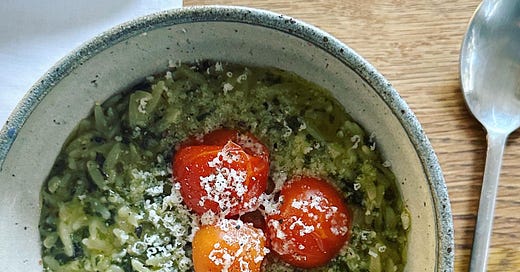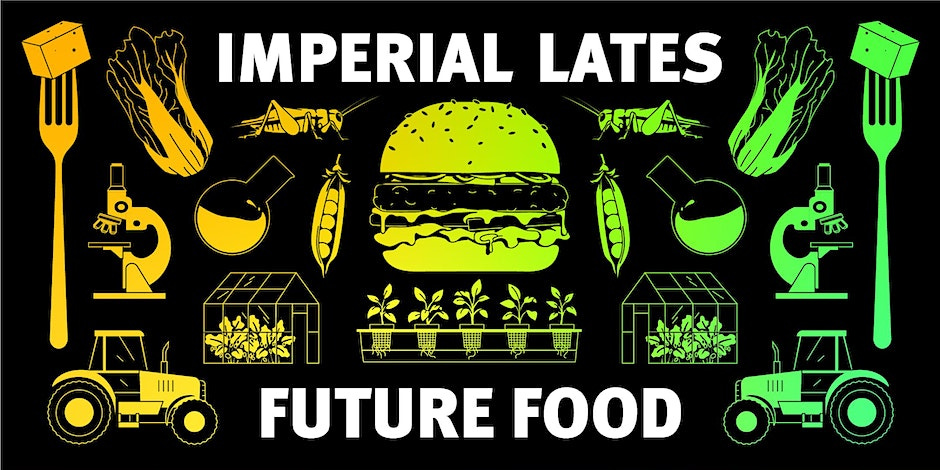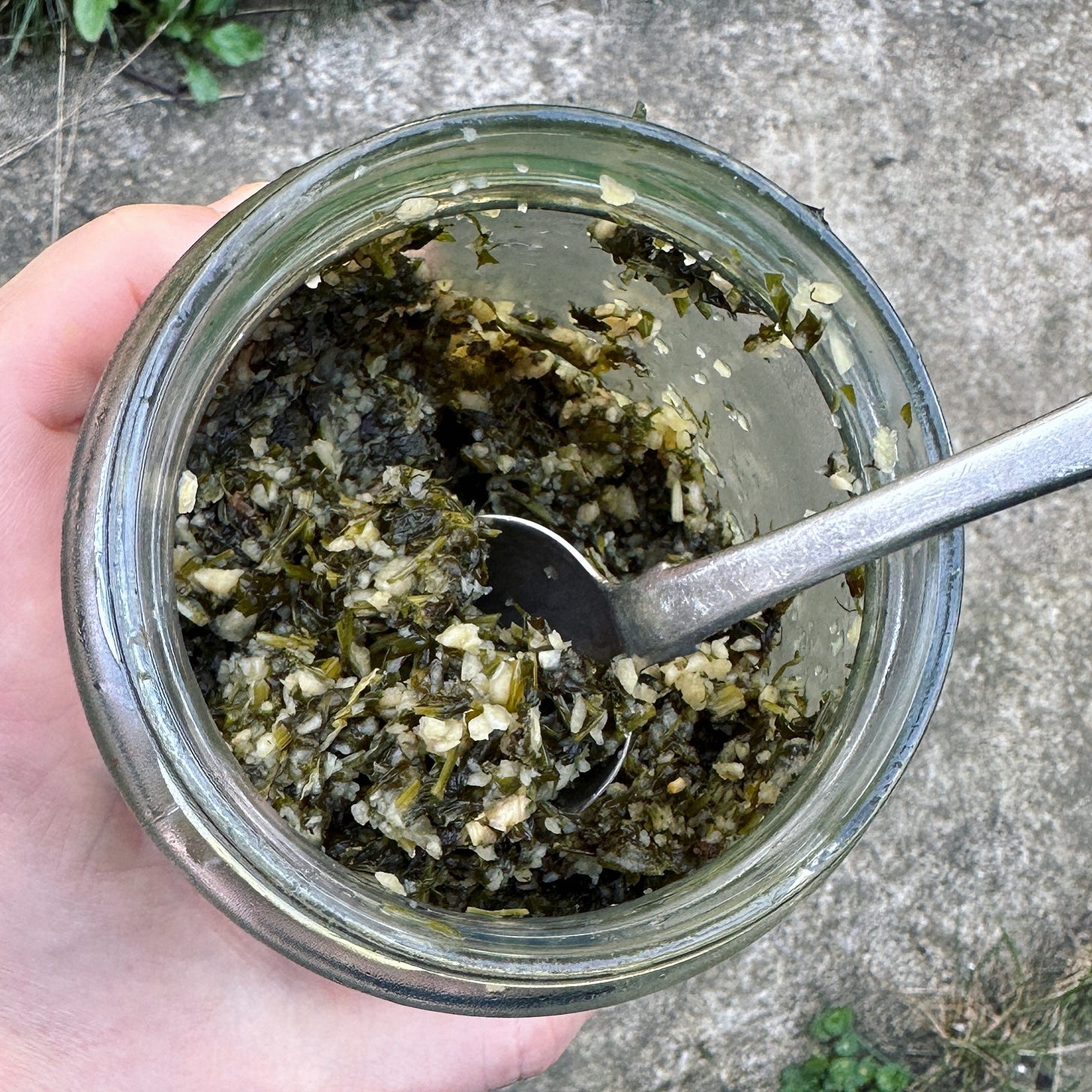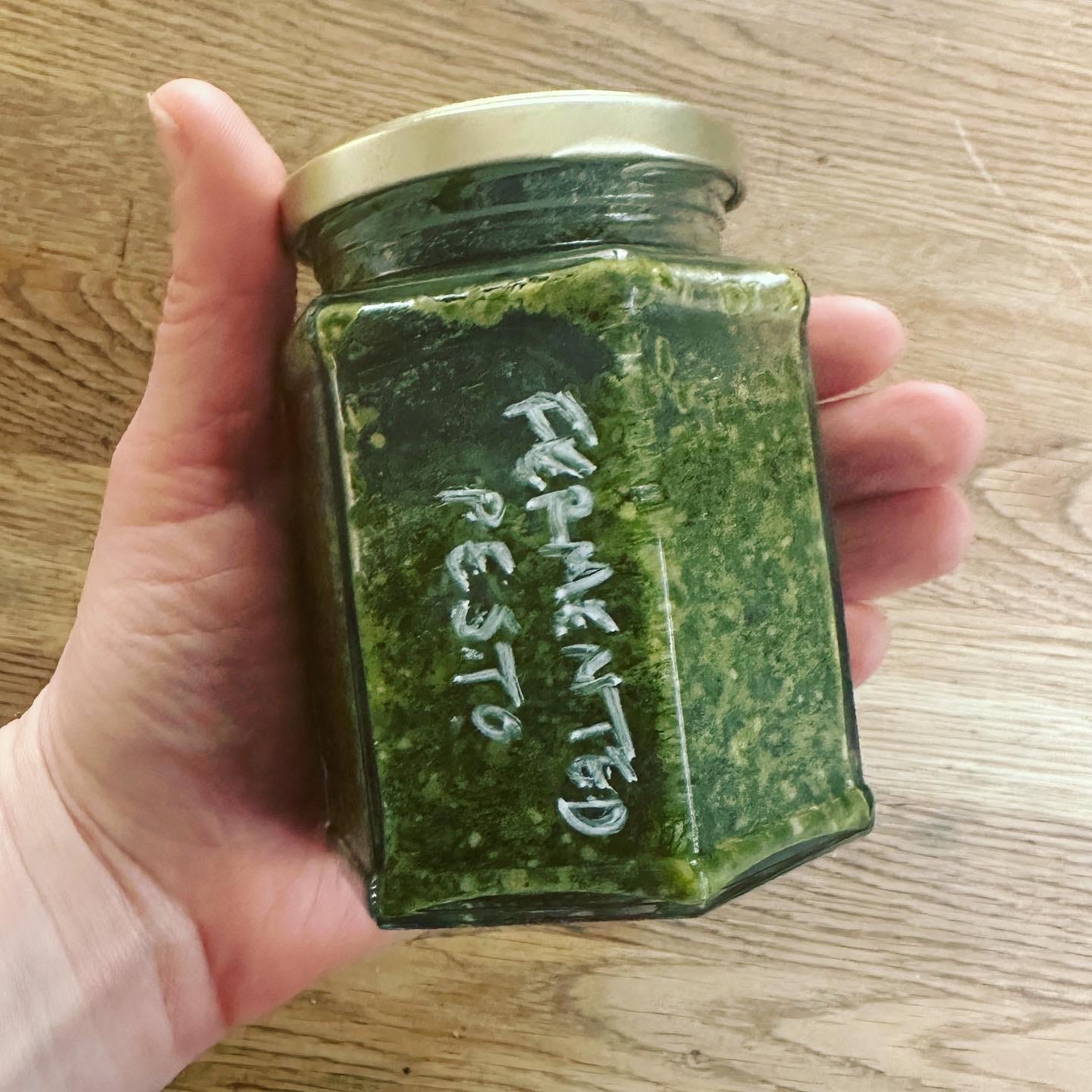In Good Taste #20: Fermented Pesto
Apologies in advance to Genoa for this delicious but inauthentic take on their classic basil sauce; plus some other lacto herb pastes; apple appreciation
Well, hello there! How are you?
Good I hope. Thank you so much for being here.
(Not up for the chitchat? Completely get it. Click the email title to go to a web-based version then jump straight to the recipes or Cultural Fun.)
Well, it’s definitely autumn now, isn’t it? Or at least it is here in North London. And it happened suddenly. On Saturday I went out without my coat then on Sunday was so chilly I had to put the heating on. Yesterday I woke up with my first cold of the season and am currently not much good for anything except drinking tea and watching back-to-back episodes of The Morning Show (Jennifer Aniston and Jon Hamm! Woof!). So today’s newsletter will be short(ish) and (relatively) to the point so I can take myself back to the sofa.
Before we get to the pesto, I wanted to let you know that I’m going to be part of the line up for Imperial Lates: Future Food on 9th November. I was really excited to be asked to contribute to this fun, social event where visitors can find out about the research currently going on at Imperial College London. There are some really interesting-sounding talks, workshops, storytelling sessions and a quiz. Plus a bar. Science, food and booze: it’s going to be great!
I’m teaming up with Dr Maria Valdivia Garcia from the Department of Metabolism, Digestion and Reproduction to run a hands-on fermentation workshop. I’ll take people through how to make their own jar of sauerkraut and Maria will talk about her research into fermented foods and gut health.
The event will run from 6-9pm at Imperial College in Kensington. It’s free but advisable to register for a place in advance. Maria and I will be running three half-hour workshops throughout the evening at 6.20pm, 7.20pm and 8.20pm. If you want to come to one of them you’ll need to get put your name down for a spot when you arrive. Hope to see you there!
Fermented Herbs
Alright. My last Lemsip is wearing off and I’m fading fast. Let’s get to it.
We’re talking this week about something that is so, so easy to make and is a really wonderful flavour boosting ingredient to have on hand in the fridge. Yet I don’t really know what to call it. I titled the newsletter “fermented pesto” because “fermented herb paste” doesn’t sound particularly appetising. But that’s what I’m on about and I want you to read it so I dropped pesto’s name to impress you. I’m sorry. There is a pesto recipe too but it’s a sub category. Really what we’re talking about are pastes. For lack of a better word.
Feeling a bit brain-foggy, I looked up “paste” in the online thesaurus and was offered “cement”, “gum” “mucilage” and “stickum”. Ugh. Worse. Much worse. I guess salsa would do but doesn’t really express the all-round usefulness of the thing. Yes, it can be used as a sauce or condiment but is also an ingredient that peps up almost anything you add it to, adding instant depth of flavour and zing.
So I have two recipes, one of which is really just a basic outline that you can adapt to whatever you have, and the other for a finished fermented pesto.
Recipe: Fermented Garlic & Herb Paste
This was a happy accident. I had some minced garlic and chopped herbs left after the Creative Krauts workshop I taught at the Garden Museum a few weeks back. I used some in cooking but there was more than I was going to get through before it went off so I followed my mantra of “in in doubt, ferment it” (I should get that put on a t-shirt). I weighed everything, added my customary 2.5% of salt, mixed it all together and shoved it in a jar. After about a week it was completely delicious and I’ve been using it ever since in salad dressings, pasta sauces and so on.
Makes one medium-sized jar. I can’t give you exact quantities but it was roughly as follows:
Ingredients
100g garlic, minced
1 large bunch herbs (approx 100g), roughly chopped
salt
Method
Make sure your jar is scrupulously clean.
Weigh the herb and garlic mixture and calculate 2.5%. Add this in salt and mix well.
Leave for a half an hour or so until the herbs have given out a little water. They won’t be swimming in brine but there should be a bit of liquid if you squish them.
Transfer the mixture to a jar and add something to weight everything down: a pickle weight or sandwich bag of brine work well.
Leave at room temperature for 1-2 weeks, tasting regularly. The garlic will lose its raw tase and mellow and the whole thing will become savoury and tart and full of umami.
Transfer to the fridge where it will keep for a good couple of months. Use spoonfuls in salad dressings, dips, sauces, stews, soups and anywhere that needs a little flavour boost.
Notes (If Ifs And Ands Were Pots And Pans…)
The herbs I had were largely coriander, parsley, dill and tarragon, weighted in favour of the coriander. But use what you have or experiment to find a mix that works for you. This is a great place to use up the stalks of soft herbs and anything on the verge of going soft in the salad drawer. Celery leaves would be a really good addition if you had some.
A spoonful mixed with olive oil and lemon juice makes a great salad dressing or drizzle for hummus and I have also been using it a lot as a kind of supercharged bouillon paste, stirring it into stews and soups to bring extra depth of flavour.
I made a similar thing a while back of coriander (I think it was mainly leftover stalks) and garlic but including finely chopped onion and jalapeño peppers too and it all fermented down into the most delicious, spicy salsa which was great on tacos etc. I put the last few spoonfuls in a cheese toastie and mourned when it was gone.
Olia Hercules has a useful, all purpose recipe for fermented herbs. This is very similar but, being lazy, I find it more useful to have everything chopped up from the beginning so you can keep a jar in the fridge and just use a spoonful when you want.
You can add a few spoonfuls of these pastes to shredded veg for a tasty kraut.Not only do they bring flavour but they bring great energy to the microbial party so it’ll probably be ready quicker than usual.
Recipe: Fermented Pesto
When I bring samples of this to workshops it’s always one of people’s favourites things. I’ve shared the recipe before on Instagram but it feels rude to send people off to go ferreting all the way down your grid so I’m putting it here too.
Apologies to the people of Genoa, not just for perverting their classic pesto with my lacto-fermenting ways but for doing it in a food processor too. Gah! Feel free to use a pestle and mortar if you like.
Makes one small jar but scale up or down as you like
Ingredients
1 large bunch of basil (approx 100g)
1 clove garlic
sea salt
25g hazelnuts, toasted if possible (see note) and roughly chopped
25g pecorino, finely grated
1 garlic clove
black pepper
50ml olive oil
Method
Roughly tear the basil and put in a food processor with the garlic. Pulse a few times until roughly chopped.
Weigh the basil-garlic mush and add about 3% of its weight in salt. Mix and let it sit for about half an hour so the salt can draw out a brine.
Put it all in a jar and add a sandwich bag filled with brine on top (or anything else that will keep the leaves under the brine and stop oxygen getting to the surface).
Leave to ferment for 5-10 days, tasting regularly. It’s ready when it still has a recognisable basil taste and aroma but also some acid and an umami note.
Put the hazelnuts, pecorino and garlic in a food processor. Pulse until they are a fine breadcrumb texture. Add the fermented basil mush, a generous grinding of black pepper and a good slug of oil. Pulse again, adding more oil if necessary until it reaches your desired consistency.
Adjust the seasoning adding more pepper if you like. It might even need a little bit of lemon juice or sugar to round it out.
Enjoy on whatever you like! It’ll keep for a few weeks in the fridge.
Notes (If Ifs And Ands Were Pots And Pans…)
I used hazelnuts the first time I made this and really liked the effect but the more traditional pinenuts are good too. I expect walnuts would be nice if you like that element of bitterness.
Whatever you go for, toasting nuts always makes them more flavourful. I find a medium oven more reliable than a dry pan. 5-10 mins at 180°C but check regularly. I know it’s an extra step and I can’t always be bothered but it makes a big difference so I’m always glad when I do. Toast a bunch at once and eat them on salads and breakfast yoghurt too.
I like the sharpness of pecorino but Parmesan or veggie equivalent would be fine too. Or try nutritional yeast for a vegan version.
Use anywhere you’d use “normal” pesto. The bowl above is a good couple of tablespoons of the pesto stirred through cooked orzo and finished with more pecorino and some Lacto Tomatoes.
Cultural Fun
It’s Apple Day on Saturday! The UK has an absurd number of apple varieties (apparently about 2500) and I love that there is a specific day to celebrate them although apple-appreciating events usually run through October.
The best one I ever went to was at the Botanic Garden in Cambridge which had a really well organised tasting and plenty of different varieties for sale. It’s on Sunday 22nd this year and I can’t go but I would recommend if you’re nearby. I also dream of going to one of the Heritage Orchard Days at Brogdale, home of the National Fruit Collection, but sadly 2023 is not the year it will happen.
Annoyingly, I can’t find a central directory of nationwide Apple Day events but do check listings near you as the opportunity to taste several varieties side by side is a really fun thing to do. Also apples have really wonderful, poetic names. Adam’s Pearmain, Brushy Mountain Limbertwig, Howgate Wonder, Kentish Fillbasket. And my favourite, the Nonnetit Bastard (although I have never seen it at a public tasting). You can see a really great directory, detailing a lot of varieties here.
I also love the Instagram account of Pomme William, an American photographer who posts the most beautiful pictures of weird and wonderful apple varieties and posts along with beautifully written descriptions.
I haven’t been to Frieze Sculpture yet this year but I’m sure it’ll be good. On in Regent’s Park until the 29th October it’s a free and a nice thing to do on an autumnal day. I always prefer seeing sculpture outside to in a gallery (it’s why I love the YSP so much) so will definitely be popping along as soon as I can shake this cold…
Bye! See you soon!
I’ll be taking next week off as it’s half term and I have lots of family things going on but will be back the week after to check on your preserved lemons and bring you some ideas of what to do with them. In the meantime, if you felt like sharing In Good Taste with friends or family who might enjoy it, you can do so with the button below. It would mean the world to me. Thanks so much.
In Good Taste is a Sycamore Smyth newsletter by me, Clare Heal.
You can also find me on Instagram or visit my website to find information about my catering work, cookery lessons and upcoming events.








